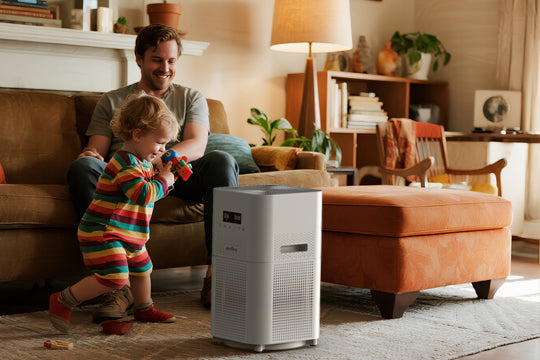
Breathe Easier with the AIRFIRE Air Purifier – HEPA Filters for Removing Allergens, Dust, and Formaldehyde
Introduction: Why Do We Need an Air Purifier?
In modern city life, we face air quality challenges every day—smog, pollen, dust, pet hair, secondhand smoke, and even formaldehyde left over from home renovations. Although invisible to the naked eye, these tiny pollutants can quietly enter our respiratory system and affect our health.
For households with elderly members, children, pregnant women, or people with allergies, indoor air quality is especially important. An Air Purifier like the AIRFIRE Series is one of the most effective tools for improving indoor air, as it can filter harmful particles, remove odors and allergens, and even reduce bacteria and viruses—making every breath safer.

How Does the AIRFIRE Air Purifier Work?
Most air purifiers work through a filtration system combined with an air circulation mechanism. The AIRFIRE Air Purifier features a high-grade HEPA (High-Efficiency Particulate Air) filter that can capture particles as small as 0.3 microns with a filtration efficiency of up to 99.97%.
It also includes an activated carbon filter to absorb harmful gases like formaldehyde and benzene, which are common in newly renovated homes. Certain models in the AIRFIRE Series add UV sterilization, negative ion purification, and smart air quality monitoring for more comprehensive purification.
Key Factors to Consider When Choosing an Air Purifier
-
CADR (Clean Air Delivery Rate)
The higher the CADR, the faster the purification speed and the larger the coverage area. Bedrooms typically require a CADR of 200–300 m³/h, while living rooms or larger spaces may need over 400 m³/h. -
Filter Grade
Choose a HEPA filter with at least H13 or H14 grade for effective removal of PM2.5, pollen, bacteria, and other pollutants. -
Noise Level
For bedroom use, look for a quiet mode with noise below 30 dB to ensure a good night’s sleep. -
Energy Consumption and Filter Cost
Energy-saving modes reduce long-term electricity costs, and the filter replacement cycle and price should also be considered. -
Smart Features
Wi-Fi remote control, real-time air quality display, and automatic fan speed adjustment can greatly improve user convenience.
When the AIRFIRE Air Purifier Can Make the Biggest Difference
-
Newly Renovated Homes: Remove formaldehyde, benzene, and other harmful gases while reducing unpleasant odors.
-
Pet Owners: Filter pet hair and dander to reduce allergy symptoms.
-
Smoggy Weather: Effectively reduce PM2.5 levels and protect the respiratory system.
-
Allergy Sufferers: Minimize exposure to pollen, dust mites, and other allergens.
Tips for Getting the Best from Your AIRFIRE Air Purifier
-
Replace filters regularly according to the manufacturer’s instructions to avoid secondary pollution.
-
Keep the air inlet and outlet clear—avoid placing the unit too close to walls or furniture.
-
Use an air quality monitor for a more accurate understanding of indoor conditions.
Conclusion: The AIRFIRE Air Purifier – Investing in Health Starts Here
The AIRFIRE Air Purifier is not a luxury—it’s a lifestyle choice for those who care about their family’s health. Whether you want to filter smog, remove formaldehyde, or reduce allergens, the AIRFIRE Series creates a cleaner, safer breathing environment.
If you’re looking for a high-performance, quiet, and smart air purifier, explore our AIRFIRE Series. Equipped with H14-grade HEPA filters and multiple purification technologies, it ensures every breath you take is fresh and safe.
